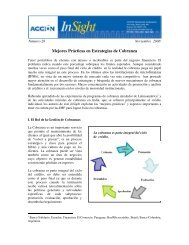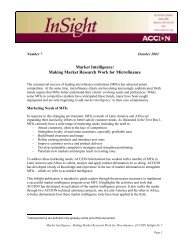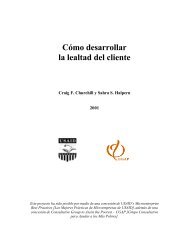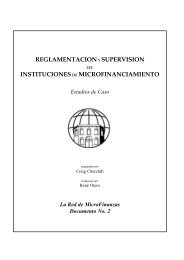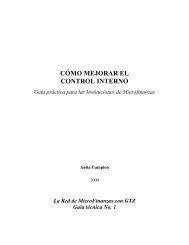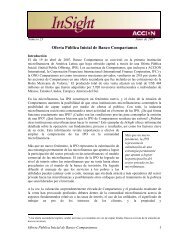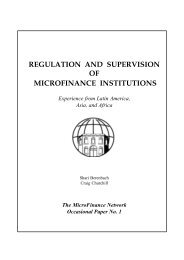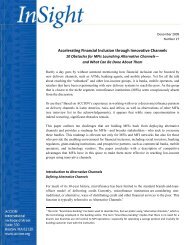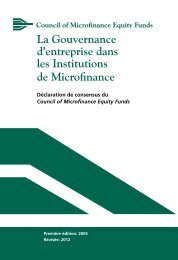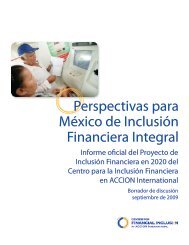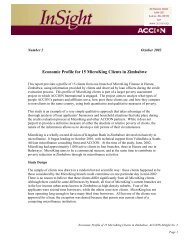the Universal Standards for Social Performance Management
the Universal Standards for Social Performance Management
the Universal Standards for Social Performance Management
You also want an ePaper? Increase the reach of your titles
YUMPU automatically turns print PDFs into web optimized ePapers that Google loves.
Executive SummaryIn June 2012, <strong>the</strong> <strong>Social</strong> Per<strong>for</strong>mance Task Force (SPTF) launched <strong>the</strong> “<strong>Universal</strong> <strong>Standards</strong> <strong>for</strong> <strong>Social</strong> Per<strong>for</strong>mance<strong>Management</strong>” (USSPM), consisting of 99 Essential Practices (EPs) in six areas. These <strong>Universal</strong> <strong>Standards</strong> areconsidered applicable to any MFI pursuing a double bottom line.Over <strong>the</strong> past year, <strong>the</strong> Microfinance CEO Working Group worked with 21 MFIs to “beta test” <strong>the</strong> <strong>Universal</strong><strong>Standards</strong>. The term “beta test” refers to an analysis of an MFI’s practices related to all of <strong>the</strong> EPs, intending tounderstand <strong>the</strong> process of an assessment and <strong>the</strong> status of an MFI’s current social per<strong>for</strong>mance management, andalso elicit any concerns or issues with <strong>the</strong> <strong>Universal</strong> <strong>Standards</strong> as <strong>the</strong>y now stand. Beta tests were conducted witha variety of partner and affiliate MFIs of <strong>the</strong> Microfinance CEO Working Group, reflecting a wide range ofinstitution sizes and geographic locations.Feedback on Process Members utilized a variety of methodologies, but learned that a full assessment is an in-depthundertaking that requires significant planning and multiple parties. All assessment methods have relative strengths and weaknesses, but ultimately <strong>the</strong> correct approachdepends on <strong>the</strong> institution’s intent (e.g., increasing awareness about social per<strong>for</strong>mance managementbest practices versus preparing <strong>for</strong> a social audit or rating). While <strong>the</strong> assessments were time consuming, participating MFIs found <strong>the</strong>m to be valuable, oftenreporting that <strong>the</strong> assessment provided education on social per<strong>for</strong>mance management best practices.Many institutions also created action plans <strong>for</strong> improving <strong>the</strong>ir practices over time.Feedback on Compliance with <strong>the</strong> USSPM Results indicate that, on average, MFIs believe that <strong>the</strong>y are already compliant with 78% of <strong>the</strong> 99Essential Practices, indicating a high degree of confidence in <strong>the</strong>ir current practices. MFIs reported highest compliance on Section 4 (Design Products, Services, Delivery Models and Channelsthat Meet Clients’ Needs and Preferences) and Section 5 (Treat Employees Responsibly). Challenges vary by institution and country context, but on average MFIs struggled most with Section 1(Define and Monitor <strong>Social</strong> Goals), and had <strong>the</strong> most concerns with Section 6 (Balance Financial and <strong>Social</strong>Per<strong>for</strong>mance).Feedback on <strong>the</strong> <strong>Universal</strong> <strong>Standards</strong> and Recommended Adjustments Our results suggest that <strong>the</strong> USSPM are, on <strong>the</strong> whole, practical and achievable <strong>for</strong> MFIs. MFIs also found<strong>the</strong> USSPM to be largely relevant to <strong>the</strong>ir organizations. However, we believe <strong>the</strong>re are some important issues that should be addressed. These issues areapplicable across <strong>the</strong> USSPM, but most especially in Section 6:o Simplify EPs that contain multiple concepts, and remove duplication of concepts between EPs.o Use clear and simple language, add explanatory examples, and develop a guide that can support MFIsin <strong>the</strong>ir assessments.o Ensure <strong>the</strong> measurability of EPs.Note that our work began be<strong>for</strong>e <strong>the</strong> launch of <strong>the</strong> SPTF’s Indicators Working Group, which aims to developindicators <strong>for</strong> each of <strong>the</strong> 99 Essential Practices. In most cases, participants believe that <strong>the</strong> release of indicatorswill help address <strong>the</strong> above issues, though some have concerns <strong>the</strong>y could add additional confusion. Exceptionalcare should be taken to make <strong>the</strong> USSPM clear and accessible to institutions of all kinds. This will be vital to make<strong>the</strong> USSPM approachable <strong>for</strong> <strong>the</strong> majority of MFIs, not just those that are already steeped in social per<strong>for</strong>mancemanagement.3



